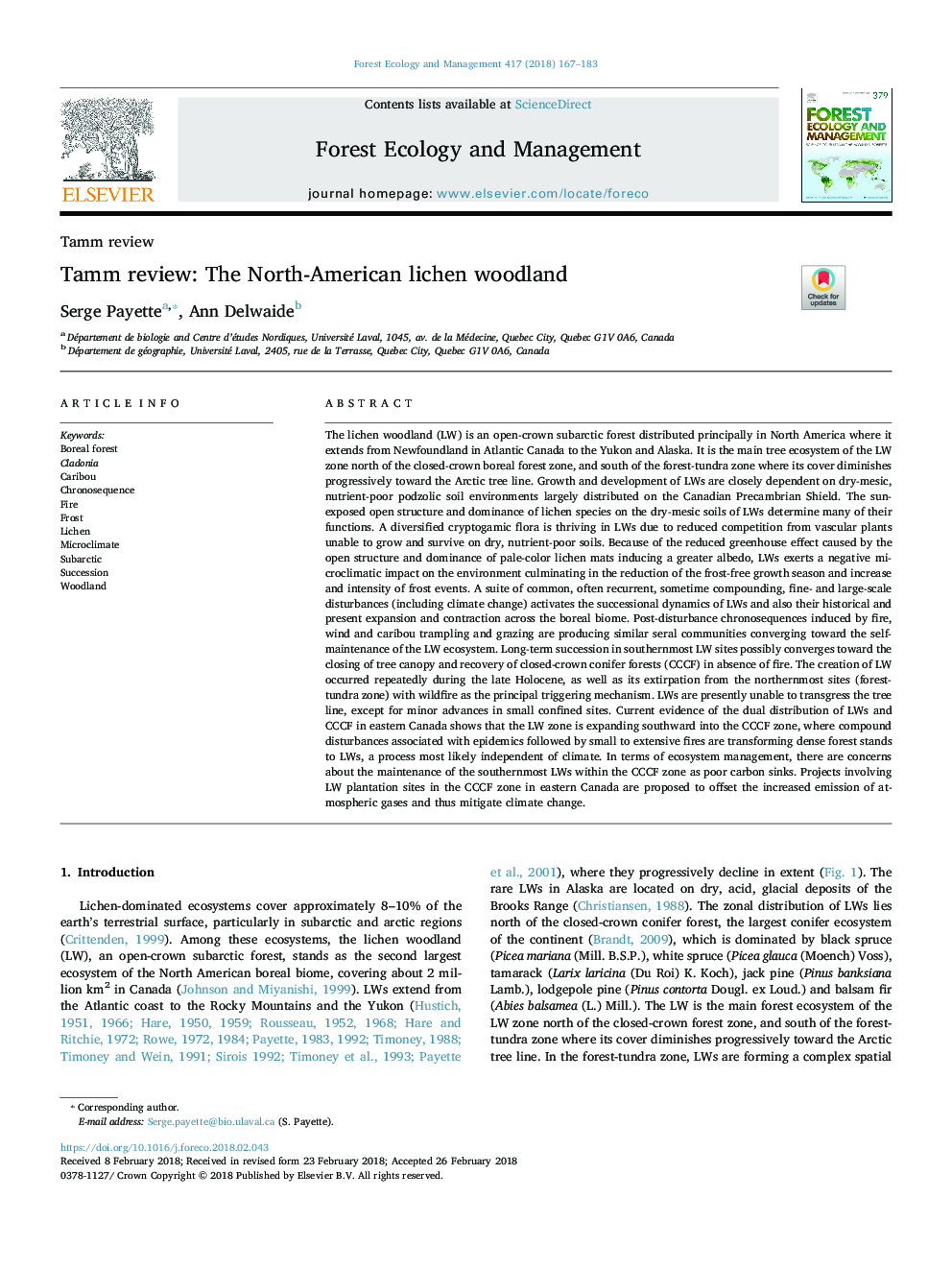| کد مقاله | کد نشریه | سال انتشار | مقاله انگلیسی | نسخه تمام متن |
|---|---|---|---|---|
| 6541735 | 1421342 | 2018 | 17 صفحه PDF | دانلود رایگان |
عنوان انگلیسی مقاله ISI
Tamm review: The North-American lichen woodland
دانلود مقاله + سفارش ترجمه
دانلود مقاله ISI انگلیسی
رایگان برای ایرانیان
کلمات کلیدی
موضوعات مرتبط
علوم زیستی و بیوفناوری
علوم کشاورزی و بیولوژیک
بوم شناسی، تکامل، رفتار و سامانه شناسی
پیش نمایش صفحه اول مقاله

چکیده انگلیسی
The lichen woodland (LW) is an open-crown subarctic forest distributed principally in North America where it extends from Newfoundland in Atlantic Canada to the Yukon and Alaska. It is the main tree ecosystem of the LW zone north of the closed-crown boreal forest zone, and south of the forest-tundra zone where its cover diminishes progressively toward the Arctic tree line. Growth and development of LWs are closely dependent on dry-mesic, nutrient-poor podzolic soil environments largely distributed on the Canadian Precambrian Shield. The sun-exposed open structure and dominance of lichen species on the dry-mesic soils of LWs determine many of their functions. A diversified cryptogamic flora is thriving in LWs due to reduced competition from vascular plants unable to grow and survive on dry, nutrient-poor soils. Because of the reduced greenhouse effect caused by the open structure and dominance of pale-color lichen mats inducing a greater albedo, LWs exerts a negative microclimatic impact on the environment culminating in the reduction of the frost-free growth season and increase and intensity of frost events. A suite of common, often recurrent, sometime compounding, fine- and large-scale disturbances (including climate change) activates the successional dynamics of LWs and also their historical and present expansion and contraction across the boreal biome. Post-disturbance chronosequences induced by fire, wind and caribou trampling and grazing are producing similar seral communities converging toward the self-maintenance of the LW ecosystem. Long-term succession in southernmost LW sites possibly converges toward the closing of tree canopy and recovery of closed-crown conifer forests (CCCF) in absence of fire. The creation of LW occurred repeatedly during the late Holocene, as well as its extirpation from the northernmost sites (forest-tundra zone) with wildfire as the principal triggering mechanism. LWs are presently unable to transgress the tree line, except for minor advances in small confined sites. Current evidence of the dual distribution of LWs and CCCF in eastern Canada shows that the LW zone is expanding southward into the CCCF zone, where compound disturbances associated with epidemics followed by small to extensive fires are transforming dense forest stands to LWs, a process most likely independent of climate. In terms of ecosystem management, there are concerns about the maintenance of the southernmost LWs within the CCCF zone as poor carbon sinks. Projects involving LW plantation sites in the CCCF zone in eastern Canada are proposed to offset the increased emission of atmospheric gases and thus mitigate climate change.
ناشر
Database: Elsevier - ScienceDirect (ساینس دایرکت)
Journal: Forest Ecology and Management - Volume 417, 15 May 2018, Pages 167-183
Journal: Forest Ecology and Management - Volume 417, 15 May 2018, Pages 167-183
نویسندگان
Serge Payette, Ann Delwaide,